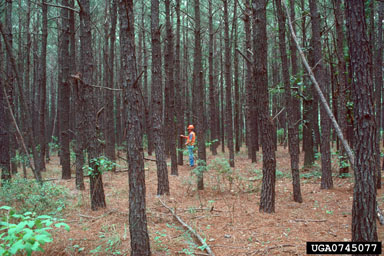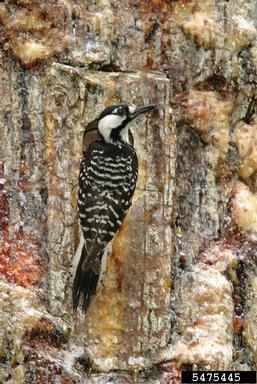Last week, I received an email from Brandless, an online store that specializes in affordable, healthy, and environmentally-conscious products. Their email was advertising their new line of “tree-free†products – paper products that are made from bamboo and sugarcane, rather than trees.
I strive to be environmentally conscious, but I am also a person who studies trees, and I can't help but bring attention to the misconceptions about the sustainability of tree products.

What is sustainable?
There has been an incredible onus on individuals to choose a sustainable lifestyle – recycle, reuse grocery store bags, eat less meat. But when we say we live sustainably or choose a brand that touts a sustainable line of toilet paper, what does that actually mean? The actual definition of sustainability is contextual and ever-changing. For the sake of a baseline definition, Webster's dictionary defines sustainability as: “of, relating to, or being a method of harvesting or using a resource so that the resource is not depleted or permanently damaged.†Which leads me to the next question:
Are trees sustainable?
In the new “tree-free†line of paper towels and bath tissue, Brandless touts bamboo and sugarcane products as biodegradable, renewable resources. Except, so are tree products. Paper products are primarily from trees that are grown in tree stands. Just like how traditional row crops are grown, these stands are large tracts of land managed to grow regionally-selected species. In Georgia, for example, the most widely planted timber crop is loblolly pine and the industry is a major economic powerhouse of the state. Loblolly is native, grows fast and hardy – once it reaches the age of 25-ish (that's fast in tree time), trees are harvested and then newly planted again.

These timber forests, while not perfect, are sustainable when trees are planted, grown, harvested, and planted again. In a previous ASO article In Defense of Trees and those Who Cut Them, Colton Meinecke illustrates that timber forests are actually beneficial, acting as natural carbon sinks and new habitats: “Harvest activities mimic natural disturbance events, like those caused by storms, fire and disease, and create habitat for ecological pioneers.†So, there are ecological similarities between timber harvest (when done right) and natural disturbances – an important facet to the infrastructure put in place.
What about our ancient trees?
Brands whose selling point is to ‘save the trees' often have advertisements showing an ancient tree being toppled over by loggers. It is a heartbreaking thing to see a tree that has been around for centuries cut down in a matter of seconds. But the fact is that most paper products are sourced from trees that are usually less than a couple decades old. Moreover, many tree products are third-party certified to be grown in sustainably-managed forests, discouraging the use of protected trees. That said, there are still many threats to these ancient forests, such as deforestation by the meat industry, climate change, land development, and illegal logging. But your toilet paper is not one of those threats.

So what's wrong with alternative paper products?
Plants like bamboo and sugarcane are incredibly fast-growing and hardy; they have unique qualities which make them useful as many products, just like trees. However, the high demand for bamboo is wreaking havoc on the native forests. In China where bamboo is primarily grown and exported, locals have cleared forests to establish bamboo stands, destroying the natural biodiversity of the region. The idea of these non-tree products is to allow forests to grow untouched, but managed-timber forests like those in Georgia have a strategic infrastructure in place to keep this resource renewable. One huge benefit to timber forests is that they are often composed of native species. This means that those trees have been growing in that region for millions of years already and have important ecological relationships with the local wildlife. Planting nonnative bamboo, on the other hand, would oust native species and hinder natural recruitment of other flora and fauna.
The big picture
Individuals thinking about their environmental impact are crucial for moving towards a better future; however, the structure of late-stage capitalism allows corporations to take advantage of people wanting to make a smart, well-meaning decision on what they choose to buy and consume. Advertising tree-free paper products as superior to responsible, sustainable forestry exists is just a marketing tool. This new genre of ‘sustainable' companies and products draws responsibility away from big companies – companies that are the world’s biggest contributors to climate change. It's kind of like the corporations are selling you a tiny Band-Aid when you have a massive headwound. And they were the ones who struck you in the head.
Real changes need drastic measures. We need to consume differently, but we also need to consume less. We also need to hold corporations, politicians, and the wealthy responsible for the climate disaster we are now bound to face.
Here are some more things you can do to address climate change
- Get involved in your local politics. You can volunteer, donate, or just read up on what your community is doing to help implement sustainable policies
- Know your farmers. An exorbitant amount of greenhouse gas emissions comes from industrial farming. If you can afford to buy local, do it!
- Call your representative. Is your representative addressing the concerns of their constituents? You can find your rep here.
- Think about what you're buying. The rate at which things are bought and thrown out is alarmingly high. Avoid fast-fashion, fast-furniture, fast-you-name-it. If you can buy it used, upcycled, recycled, or something that won't break after some use (ahem, IKEA furniture and Forever21), that would be the best choice in the long run
Lead image: “Bright colorful paper straws” by wuestenigel is licensed under CC BY 2.0
About the Author

Simone Lim-Hing
Simone Lim-Hing is a postdoctoral researcher at the University of Georgia Warnell School of Forestry and Natural Resources studying the host response of loblolly pine against pathogenic fungi. Her main interests are chemical ecology, ecophysiology, and evolution. Outside of the lab and the greenhouse, Simone enjoys going to local shows around Athens, playing Mario Kart, and reading at home with her cat, Jennie. You can reach Simone at simone.zlim@uga.edu or on twitter @simonelimhing. More from Simone Lim-Hing.
- Simone Lim-Hing#molongui-disabled-link
- Simone Lim-Hing#molongui-disabled-link







